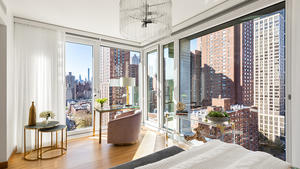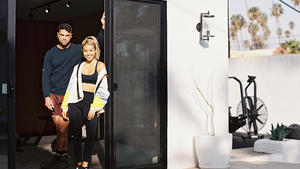Once you’re in the door, there’s plenty of advice floating around about style, project management, budget and all the rest—but how do you actually get the job in the first place? We’re asking designers to peel back the curtain and walk us through how they landed a project, step by step. Here, Australian designer Blainey North explains how she was tapped to imagine a $21 million model apartment on the 66th floor of the Central Park Tower in New York.

What’s the backstory of this project?
It was actually just a random phone call. They asked me to sign a confidentiality agreement, which quite often happens, and then revealed what the project was and asked if we’d be interested. A lot of our work is luxury residential, so I think that Extell [Development Company] had seen some of our work, or we won quite a lot of international competitions over the last couple of years. The brief was that they wanted the interiors to feel like a luxury home rather than a display apartment. Our approach is usually turnkey, in that we’re doing the interior architecture, the interiors, the furniture, and custom-designing all the bits and pieces, curating art. They liked that.
What and where are your typical projects?
We work everywhere in the world. We’ve done projects in London, in the Maldives, Fiji, of course Australia, Aspen, Los Angeles. We’ve got quite a lot of projects in New York at the moment. I’ve had the business for 20 years now; we started in very, very high-luxury hotel interiors doing six-star hotels and specializing in presidential suites and villas. And then have gone into super-luxury homes—so super-yachts and those kinds of things. One of the homes we worked on in Australia was an apartment that just sold for AU$60 million [$44 million]. We do a lot of homes upwards of AU$30 million.

So how did you make the space feel like a real home, not a display apartment?
We thought about this idea of the sound of New York. I’m always struck when I come to New York from anywhere else in the world—there’s this noise and hum. Central Park is the only moment of quiet you can actually get in the city, so we wanted these apartments to feel like a pause in the sound: so that when you sat in the room, everything slows down because of your relationship to the park, but the walls and the edges of the space are almost embedded with the idea of the sound of New York.
We looked at how music and rhythm could be translated into any interior, and we worked with an artist in London called Nadia-Anne Ricketts, who has developed this amazing program to digitize music into a visual representation and then weave it into textiles. So the walls of the grand salon have “Lucy in the Sky With Diamonds.” Then we worked with a rug company to develop designs [where] we looked at Mondrian’s work for New York and his Broadway Boogie Woogie, representing the rhythm of Manhattan, which felt very much relative to the sound. We’ve included a ceramic artist called Daniel Schneider, who’s from L.A. and does a lot of brutalist ceramic work; the way the work moves feels a bit like rhythm and sound. These are all just examples.

What’s your favorite room in the apartment?
The grand salon. The columns and walls that sit next to the view are clad in mirrored wallpaper and have fluted tubes of glass all around. It creates this beautiful reflection of the view, so the view merges into the apartment, if you will. It also makes these walls and the columns at the edges of the room disappear.
What was it like to do all of this between New York and Australia during the pandemic? Was it just one zillion Zooms?
I’m lucky to have an amazing team in New York, and we worked on this project for two years. I think I left New York the day they announced that there were 50 cases. We do work all around the world, so we have great systems in place to manage projects. We work a lot in 3D to present to the clients, and we also work in virtual reality. They put on a headset, and I put on a headset. That technology, we started to develop here in Australia with our vendors and was really great over the pandemic. The only thing that was harder was the suppliers; a lot of suppliers were affected by the pandemic and it meant that we needed to consider different suppliers in some instances and be really dynamic to make sure that all of the bits and pieces could get in on time.
What is your typical first interaction with a client?
It’s always meeting them in person or on Zoom and asking them how they want their space to feel. Often, people might have an idea of what they want in a brief, but I find when you ask, “What is it that you want this space to feel like when you walk in?” usually people are able to tell you really succinctly exactly what they want. And that really helps us, because it means that we can tailor the concept to work around that feeling.

What do you typically wear when you’re meeting a client for the first time?
I’m a great lover of fashion. As my daughter would say, “Mom, you’re so fancy.” I find that really interesting, to see people representing who they are inside on the outside. I love getting dressed in the morning and putting [together] my outfit by however I’m feeling on that particular day.
Quite often, we use fashion images to portray [design] concepts because there might be a similar concept coming from fashion or there might be a beautiful color palette that you can see in clothes. I find fashion a really great tool of communicating texture, color or ideas.
How do you present the design concept to clients?
We usually present in a concept deck. For Central Park Tower, we had images of the different music in New York and the way that sound travels, and then we looked at how sound had been represented in interiors over time. All of those images were in the initial part, and then there was a feel of what each area would look like. After we’d done that initial presentation, we worked through every single room, quite often now in three dimensions. You can’t really tell the difference between a photograph and these renders, where we model up the whole space and look at the furniture and the fabric.
We are really excited about doing this virtual reality as well, because it means that someone can stand in the room and zoom to the corners and zoom into the table and the fabrics. That’s as close as we’ve ever been to experiencing what the space would be like before it’s built. It’s really great for a client, and it’s also an amazing tool for the builders, because they can see what they’re about to build. Communicating with the stone contractor, you can show this thing and say, “This is how we’re imagining we’re going to tile the bathroom, and this is what the stone looks like, and this is how it meets the doorframe.” Everyone has a vision of where they’re headed.
What do you bring to a site visit?
A measuring tape, my site boots and PPE. I’ve always got a notebook and pen because I like writing physically. And, of course, the drawings.

How do you turn down a client who’s not a great fit?
Well, we do have quite a big wait list, and we only take on as many projects as my team can take on. I’ve got 25 staff worldwide, and I love that size; it means that I have communication with all of them every day and that I’m involved in every project in a very real way. I’m very invested emotionally in each project, and I have a very close relationship with my clients. I like the fact that one of my clients can call me and say, “Hey, what’s the tap in the powder room?” and I can say, “Oh, it’s the blah blah blah,” and just know the answer. We only take on as many projects as we can take on to allow that to work. That does mean that we do turn away quite a lot of projects, but I feel really lucky that I’m at a point in my life where I can do that.
Homepage photo: A view of the grand salon with its musical wallcovering | Jason Schmidt





























